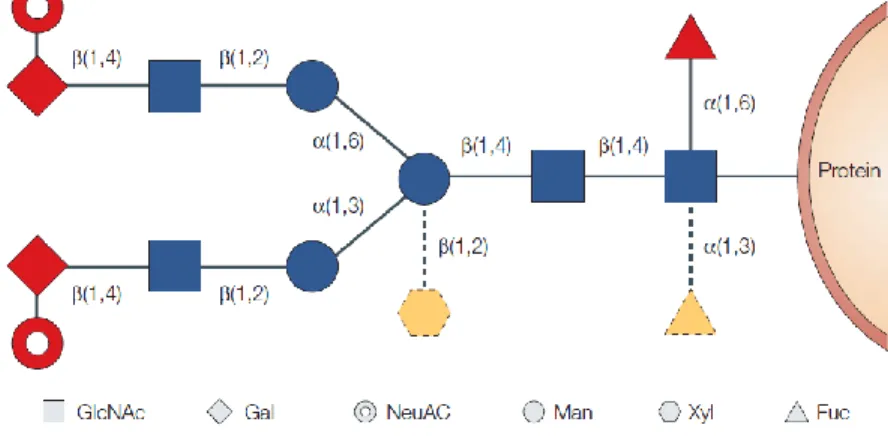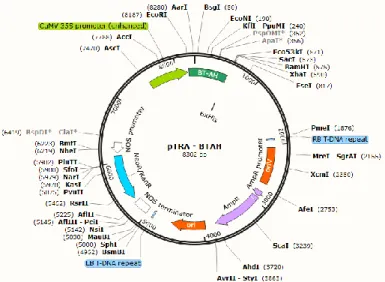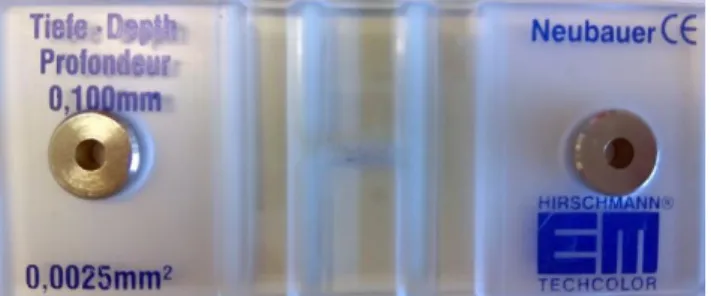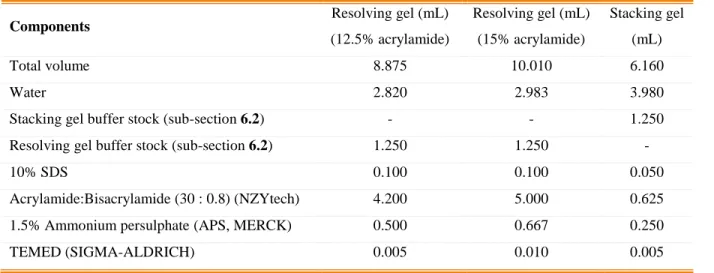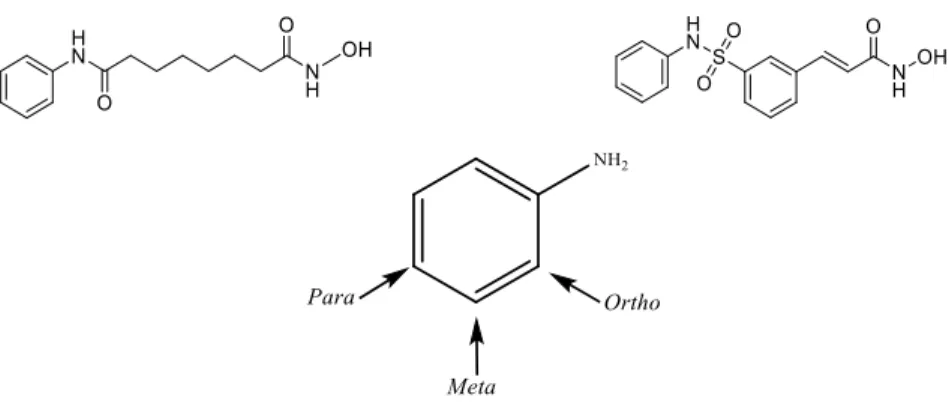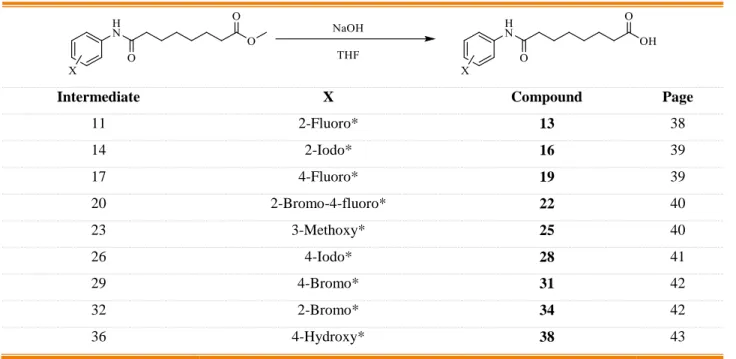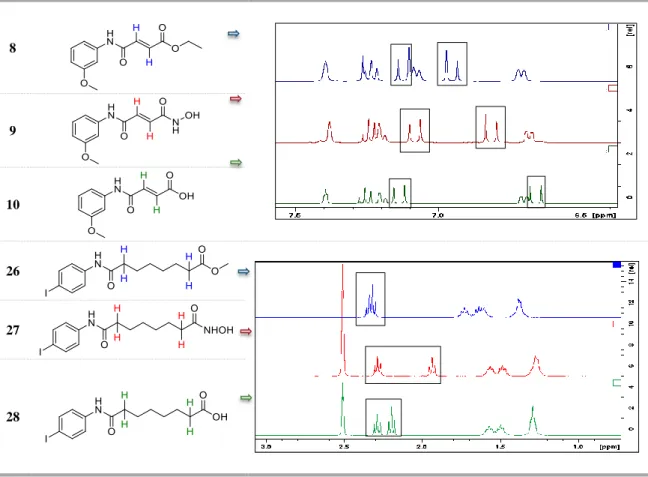Bárbara Almeida Rebelo
Bachelor degree in BiochemistryChemical synthesis of new histone deacetylase inhibitors
and their evaluation as inducers of recombinant protein
production in plants
Dissertation to obtain the Master Degree in Biochemistry for Health
Supervisor: Rita Ventura, PhD, ITQB-NOVA
Co-supervisor: Rita Abranches, PhD, ITQB-NOVA
Bárbara Almeida Rebelo
Bachelor degree in Biochemistry
Chemical synthesis of new histone deacetylase inhibitors
and their evaluation as inducers of recombinant protein
production in plants
Dissertation to obtain the Master Degree in Biochemistry for Health
Supervisor: Rita Ventura, PhD, ITQB-NOVA
Co-supervisor: Rita Abranches, PhD, ITQB-NOVA
Jury
President: Dr. Pedro Manuel H. M. Matias, Senior Researcher, ITQB-NOVA Main examiner: Dr. Hélder João Ferreira Vila Real, Postdoc Researcher, IBET Examiner (s): Dr. Margarida Archer Franco Frazão, Auxiliary Researcher, ITQB-NOVA
Dr. Maria Rita Mendes Bordalo Ventura, Auxiliary Researcher, ITQB-NOVA
Instituto de Tecnologia Química e Biológica António Xavier da Universidade Nova de Lisboa
III
Chemical synthesis of new histone deacetylase inhibitors and their
evaluation as inducers of recombinant protein production in plants
Copyright – Bárbara Almeida Rebelo, ITQB-NOVA
O Instituto de Tecnologia Química e Biológica António Xavier e a Universidade Nova de
Lisboa têm o direito, perpétuo e sem limites geográficos, de arquivar e publicar esta dissertação
através de exemplares impressos reproduzidos em papel ou de forma digital, ou por qualquer
outro meio conhecido ou que venha a ser inventado, e de a divulger através de repositórios
científicos e de admitir a sua cópia e distribuição com objetivos educacionais ou de investigação,
não comerciais, desde que seja dado credito ao autor e editor.
V
A
CKNOWLEDGMENTS
First of all, I would like to express gratitude for my supervisor Rita Ventura, for having believed in me from the beginning, for her concern for my work, for her availability, for her dedication and for her advice. Thank you for having me in your group, allowing me to enter the world of research. I would like to thank my other supervisor, Rita Abranches, for all her dedication, trust and support that always showed me and for gather all the necessary conditions for the development of this study. Thank you for all the knowledge and confidence I gained during this time.
I must thank Diana Lousa from Protein Modelling Lab at ITQB for all the knowledge transmitted for this project. For all the willingness to help me whenever I needed, I cannot thank you enough.
A special thank you to all the people at Bioorganic Chemistry Lab and Plant Cell Biology Lab for welcoming me and teach me. I am grateful especially to Osvaldo Ascenso and Rita Santos for their valuable help in the development of my work, Vanessa Miranda for being always available and João Cascão and Márcia Rénio for their friendship, companionship and tireless support.
To all my friends from Mangualde, Covilhã and Lisboa, especially to António Lopez, for all the support and affection that have always given to me. To everyone with whom I always smile, studied and enjoyed myself over the years.
Finally, I cannot never express my totally gratitude to family for the support in my decisions; to my parents for allowing me to finish another important stage in my life and to my brother for the love and confidence, and just for being there.
VII
A
BSTRACT
Transgenic plants offer several advantages for the production of recombinant proteins with pharmaceutical value. Moreover, plant suspension cell cultures combine the benefits of plants with the advantages of recombinant protein production by microbial cell cultures.
Histones are proteins that are essential in gene expression control through several modifications like acetylation, phosphorylation and methylation. Histone acetyltransferases and histone deacetylases regulate the expression levels via acetylation and deacetylation of lysine residues in histones. Therefore, histone acetylation is associated with an increase in transcription levels, resulting in higher protein production levels. Inhibitors of these HDACs have been associated with the treatment of prostate and lymphoma cancer, reactivation of latent HIV cells and they also behave as small molecular enhancers for recombinant protein production.
The purpose of this work was to synthesise new HDAC inhibitors derived from the commercial inhibitors SAHA and Belinostat. Overall, forty compounds were successfully synthesised where key aspects of the HDACis structure were altered. Nicotiana tabacum BY2 cell suspension cultures expressing a human lipocalin-type prostaglandin D2 synthase were used in order to evaluate the newly
synthesised compounds as production enhancers of this protein.
Results show that compounds N'‐(2‐fluorophenyl)‐N‐hydroxyoctanediamide (12) and (2E)-N'‐(2‐ bromo‐4‐fluorophenyl)‐N‐hydroxybut‐2‐enediamide (6) were efficient HDACis. They increased the acetylation levels and were functional as L-PGDS production enhancer. Commercial N-Hydroxy-N'-phenyloctanediamide (SAHA) significantly increased the acetylation levels but not L-PGDS production. The present work paves the way for employing epigenetic strategies to improve recombinant protein production by plant cell cultures.
Keywords: Molecular Farming, tobacco BY2 cell cultures, chemical synthesis, HDAC inhibitors, L-PGDS, histone acetylation
IX
R
ESUMO
As plantas transgénicas possuem características vantajosas para a produção de proteínas recombinantes com valor farmacêutico. As culturas de células vegetais em suspensão combinam os benefícios das plantas com as vantagens de produção de proteínas recombinantes por culturas de células microbianas.
As histonas são proteínas essenciais para o controlo da expressão genética através de modificações na acetilação, fosforilação ou metilação. As histonas acetiltransferases e histonas deacetilases regulam os níveis de expressão através da acetilação e deacetilação de resíduos de lisinas presentes nas histonas. Por sua vez, a acetilação de histonas está associada a um aumento dos níveis de transcrição, resultando num aumento de produção de proteínas. Os inibidores das HDACs estão associados ao tratamento do cancro da próstata e linfoma, reactivação de células de HIV latentes e como potenciadores da produção de proteínas recombinantes.
Um dos objectivos deste trabalho foi a síntese de novos inibidores de HDAC derivados de inibidores comerciais, como o SAHA e o Belinostat. Foram sintetizados quarenta compostos com êxito, com alterações nos domínios-chave da estrutura dos inibidores. Neste estudo utilizou-se culturas de células de Nicotiana tabacum BY2 em suspensão, expressando a proteína recombinante prostaglandina D2 sintetase humana do tipo lipocalina, para avaliar o efeito dos compostos sintetizados na produção desta proteína.
Os resultados demostram que os compostos N'-(2-fluorofenil)-N-hidroxoctanediamida (12) e (2E)-N'-(2-bromo-4-fluorofenil)-N-hidroxibut-2-enediamida (6) funcionaram eficientemente como HDACis. Estes compostos produziram um aumento dos níveis de acetilação e potenciaram a produção de L-PGDS. O composto comercial N-hidroxi-N'-feniloctanediamida (SAHA) aumentou significativamente os níveis de acetilação, mas não a produção de L-PGDS. O presente trabalho demonstra a validade para a aplicação de estratégias epigenéticas com o objectivo de melhorar a produção de proteínas recombinantes em culturas de células vegetais.
Palavras-chave: Molecular Farming, culturas celulares BY2 de tabaco, síntese química, inibidores de HDAC, L-PGDS, acetilação de histonas.
XI
L
IST OF CONTENTS
1 Introduction ... 1
1.1 Molecular farming ... 1
1.1.1 Plant cell suspension cultures ... 4
1.1.2 Limitations and optimisation of downstream processing ... 5
1.1.3 Post-translational modifications ... 6
1.2 Nicotiana tabacum as an expression platform for recombinant proteins ... 8
1.2.1 Prostaglandin-D synthase (PGDS, lipocalin type) ... 9
1.3 Epigenetic modifications... 9
1.4 Design and development of HDAC inhibitors. ... 11
1.4.1 HDACi synthesis... 13
1.4.2 HDACis: multitarget compounds ... 15
1.5 Objectives ... 16
2 Material and methods ... 17
2.1 Chemistry ... 17
2.1.1 Compound characterization and purification ... 17
2.1.2 General procedure for the amide bond formation ... 18
2.1.3 General procedure for hydroxamic acid formation ... 28
2.1.4 General procedure for carboxylic acid formation ... 37
2.2 Plant Material ... 45
2.2.1 BY2 cell transformation ... 45
2.2.2 Maintenance of BY2 cell suspension cultures ... 46
2.2.3 Characterization of BTAH4 growth curve ... 46
2.2.4 Nuclei extraction ... 47
XII
2.2.6 Analysis of HDAC inhibition ... 48
2.2.7 Histone extraction ... 48
2.3 Protein Analysis ... 49
2.3.1 Bradford protein assay ... 49
2.3.2 Sample preparation for SDS – PAGE ... 49
2.3.3 SDS – PAGE Gel Preparation ... 50
2.3.4 Protein transfer from SDS-PAGE gel to nitrocellulose membrane ... 51
2.4 Recombinant L-PGDS immunodetection ... 51
2.5 Analysis of Histone H3 acetylation levels ... 51
3 Results and Discussion ... 53
3.1 Synthesis of HDACis ... 53
3.1.1 Amide formation ... 57
3.1.2 Synthesis of carboxylic acid compounds ... 59
3.1.3 Synthesis of hydroxamic acid compounds ... 60
3.2 Theoretical prediction of the optimal conformation and relative orientation between HDAC and the ligands ... 65
3.3 HDACi evaluation as enhancers of protein production ... 70
3.3.1 In vitro screening of compounds as potential HDAC inhibitors ... 70
3.3.2 In vivo testing of compounds 6, 10, 12, 15, 18 and SAHA ... 72
3.3.3 Evaluation of the effect caused by compound 12 ... 77
3.3.4 Evaluation of the effect caused by SAHA ... 80
3.3.5 Evaluation of the effect caused by compound 6 ... 83
4 Conclusions ... 87
5 Bibliography ... 91
6 Appendix ... 95
6.1 Solvents distillation ... 95
XIII
F
IGURE INDEX
Figure 1-1- Simple illustration of the process of molecular farming. . ... 1
Figure 1-2- Approval numbers for biopharmaceuticals products in the United States and European Union ... 2
Figure 1-3- Structure of the glycan chain in humans and plants.. ... 7
Figure 1-4- Histone acetylation, chromatin condensation and gene expression. ... 10
Figure 1-5- Structure of suberoylanilide hydroxamic acid (SAHA) with its three important domains ... 12
Figure 1-6- The synthetic route of the target compounds using suberic acid monomethyl ester as starting material.. ... 14
Figure 2-1- Representation of pTRA-BT-AH (L-PGDS) plasmid. ... 45
Figure 2-2- Schematic representation of the L-PGDS T-DNA region. ... 45
Figure 2-3- An "H" shaped haemocytometer with two counting chambers. ... 46
Figure 2-4 – Mini-PROTEAN tetra cell component. ... 50
Figure 3-1- Structural representation of the commercial HDACis SAHA (left) and Belinostat (right) .... 53
Figure 3-2- 1H-NMR spectra of compounds 8, 9, 10, 26, 27 and 28 and their respective structure. ... 63
Figure 3-3- Clustering histogram of all docking solutions, as a function of BFE, for all the synthesised hydroxamic compounds (left) and carboxylic compounds (right). ... 66
Figure 3-4- Predicted binding of SAHA (left) and compound 6 (right) to Hdac2. ... 67
Figure 3-5- Molecular docking results of Hdac2 crystal structure with docked SAHA (A), compound 6 (B), compound 12 (C) into catalytic site ... 68
Figure 3-6- Measurement of the amount of deacetylated product (A), activity (B) and inhibition (c) of total HDAC enzyme for each synthesised compound... 71
Figure 3-7- Chemical structure of the synthesised compounds chosen after analysis of the results obtained in the kit Epigenase. ... 72
Figure 3-8- Results obtained for the assays with 10 µM of each inhibitor and respective control. ... 73
Figure 3-9- SDS-PAGE (A) and western blot (B) analysis of L-PGDS levels in BY2 cell culture. Culture medium was collected on day 0, 2, 4 and 7, before (C0, C2, C4, C7) and after treatment with 10 µM of compound 12 (5(1), 7(1)) and compound 18 (4(2), 7(2)).. ... 74
Figure 3-10- SDS-PAGE (A) and western blot (B) analysis of L-PGDS levels in BY2 cell culture. Culture medium was collected on day 0, 2, 5 and 7, before (C0, C2, C5, C7) and after treatment with 10 µM of compound 15 (5(1), 7(1)) and compound 6 (5(2), 7(2)). ... 75
XIV Figure 3-11- SDS-PAGE (A) and western blot (B) analysis of L-PGDS levels in BY2 cell culture. Culture medium was collected on day 0, 2, 4 and 7, before (C0, C2, C4, C7) and after treatment with 10 µM of compound 10 (4(1), 7(1)) and SAHA (4(2), 7(2)). ... 75 Figure 3-12- SDS-PAGE (A) analysis for each inhibitor and respective control on day 7, stained with Blue safe and western blot detecting L-PGDS (B) ... 76 Figure 3-13- (A) - Growth curve and total soluble protein (TSP) of BY2 cultures expressing L-PDGS with and without inhibitor 12. ... 77 Figure 3-14- Analysis of BY2 culture medium by SDS-PAGE (C1), stained with Blue safe, and western blot detecting L-PGDS (C2) ... 78 Figure 3-15- The resulting extracts from histone extraction were analysed by SDS-PAGE (D1) and western blotting: detection of acetyl-Histone H3 (D2) and Histone H3 (D3).. ... 79 Figure 3-16- (A) - Growth curve and total soluble protein (TSP) of BY2 cultures expressing L-PDGS with and without inhibitor SAHA addition.. ... 80 Figure 3-17- Analysis of BY2 culture medium by SDS-PAGE (C1), stained with Blue safe, and western blot detecting L-PGDS (C2) ... 81 Figure 3-18- The resulting extracts from histone extraction were analysed by SDS-PAGE (D1) and western blotting: detection of acetyl-Histone H3 (D2) and Histone H3 (D3) ... 82 Figure 3-19- (A) - Growth curve and total soluble protein (TSP) of BY2 cultures expressing L-PDGS with and without inhibitor 6 addition. ... 83 Figure 3-20- Analysis of BY2 culture medium by SDS-PAGE (C1), stained with Blue safe, and western blot detecting L-PGDS (C2). ... 84 Figure 3-21- The resulting extracts from histone extraction were analysed by SDS-PAGE (D1) and western blotting: detection of acetyl-Histone H3 (D2) and Histone H3 (D3). ... 85
XV
T
ABLE INDEX
Table 1-1- List of biopharmaceuticals produced in several plant cell suspension cultures ... 3 Table 1-2- Comparison of different aspects of several expression platforms for the production of pharmaceuticals... 5 Table 1-3- List of HDACis, including their structure, and information about the treatment applications. 13 Table 2-1- Preparation of resolving and stacking gels. ... 50 Table 3-1- Structure, IUPAC name and yield of all synthesised compounds, intermediates and final products. ... 54 Table 3-2- General route for amide synthesis using mono-ethyl fumarate as starting material and different anilines. ... 58 Table 3-3- General route for amide synthesis using suberic acid monomethyl ester as starting material and different anilines. ... 58 Table 3-4– The synthetic route to compound 35 production, involving demethylation of compound 23. 59 Table 3-5- Synthesis of carboxylic acid derivatives from compounds present in Table 3-2. ... 59 Table 3-6- Synthesis of carboxylic acid derivatives from compounds present in Table 3-3. ... 60 Table 3-7- Synthesis of hydroxamic acid derivatives from intermediate compounds present in Table 3-2. ... 60 Table 3-8- Synthesis of hydroxamic acid derivatives from intermediate compounds present in Table 3-3. ... 61 Table 3-9- Application of DBU-based protocol for the synthesis of compound 37, a hydroxamic acid. .. 62 Table 3-10- New synthesis of phosphate-derived compound 42 and compound 44, a hydroxamic and carboxylic acid, respectively. ... 62 Table 3-11- Description of the amino acid sequences of Arabidopsis thaliana, Homo sapiens and Saccharomyces cerevisiae producing significant alignments in comparison with Nicotiana tabacum amino acid sequence. ... 65 Table 3-12- Sequences available in PDB producing significant alignments in comparison with Nicotiana tabacum histone deacetylase 6 sequence. ... 66
XVII
ABBREVIATIONS
APS - Ammonium persulfate Ar – Aromatic
BBr3 – Boron tribromide
BFE – binding free energy
BLAST – Basic local alignment search tool BnOH – Benzyl alcohol
BSA – Bovine serum albumin BY2 – Bright yellow 2 CCl4 – Carbon tetrachloride
CDCl3 – Deuterated chloroform
CH3CN - Acetonitrile
CLA-1 – Lysosomal integral membrane protein-II analogous-1 DBU – 1,8-Diazabicyclo[5.4.0]undec-7.ene
DCM – Dichloromethane
DIPEA – N,N-diisopropylethylamine DMF – Dimethylformamide
DMSO – Dimethyl sulfoxide
DMSO-d6 – Deuterated dimethyl sulfoxide
DNA – Deoxyribonucleic acid
EDC – 1-Ethyl-3-(3-dimethylaminopropyl)carbodiimide EtOAc – Ethyl acetate
EtOH – Ethanol
FDA – Food and Drug Administration
FT-IR – Fourier transform infrared spectroscopy GMP – Good manufacturing practice
h – Hours
HAT(s) – Histone acetyltransferase(s) HCl – Hydrochloric acid
HDAC(s) – Histone deacetylase(s)
HDACi(s) – Histone deacetylase inhibitor(s) Hex – Hexane
HIV – Human immunodeficiency virus Hz – Hertz
KH2PO4 – Monopotassium phosphate
L-PGDS – Lipocalin-type prostaglandin D2 synthase MARs – Matrix attachment regions
MeOH – Methanol
MgCl2 –Magnesium chloride
MgSO4 – Magnesium sulphate
MHz – Megahertz Min – Minute
XVIII MS – Murashige & Skoog
Na2HPO4 – Disodium hydrogen phosphate
NaCl – Sodium chloride
NAD – Nicotinamide adenine dinucleotide NaHCO3 – Sodium bicarbonate
NaOH – Sodium hydroxide NH2OH – Hydroxylamine
NH2OH·HCl – Hydroxylamine Hydrochloride
NMR – Nuclear magnetic resonance PBS – Phosphate-buffered saline
PBS-T - Phosphate-buffered saline with tween-20 PDB – Protein data bank
PGDS – Prostaglandin-D synthase PMSF – Phenylmethanesulfonyl fluoride Ppm – Parts per million
PTM – Post-translational modification RNA – Ribonucleic acid
RT – Room temperature SAHA - Vorinostat
SDS – Sodium dodecyl sulfate
SDS-PAGE – Sodium dodecyl sulfate – polyacrylamide gel electrophoresis SME(s) – Small molecular enhancer(s)
THF – Tetrahydrofuran
TLC – Thin-layer chromatography TSA – Trichostatin A
1
1 INTRODUCTION
1.1 Molecular farming
Plants are a simple and efficient bioproduction system for human survival, producing fibers, foods, wood and secondary metabolites with therapeutic effects. The evolutionary development of plants caused these metabolites to play a protective role against pathogens or predators, because of their anti-inflammatory, antimicrobial and psychoactive properties. Nowadays, it is imperative to produce new and effective compounds for further applications, so modern biotechnology pursues and investigates new paths to obtain these therapeutics in a controlled environment using cell cultures originated from the respective plant (Boehm, 2007).
Plant molecular farming is a branch of biotechnology, where plants are engineered to produce industrial and recombinant pharmaceutical proteins in large quantities. This technology involves several steps, such as the growing, harvesting, transport, storage, downstream process and protein purification (Boehm, 2007; Obembe et al., 2011). Advances in genomics and proteomics facilitate the identification and characterization of useful genes for placing into plant expression vectors, transforming the plants into transgenic plants to further administrate as need, as demonstrated in Figure 1-1 (Yao et al., 2015).
Figure 1-1- Simple illustration of the process of molecular farming, including the process of transformation and the applicability of the product, topical, intravenous or edible vaccines administration (adapted from Yao et al., 2015).
The development of genetic systems expressing foreign proteins in plants is facilitated by recombinant deoxyribonucleic acid (DNA) technology (Moustafa et al., 2015). Furthermore, alterations in specific genes or regulatory DNA sequences of the plant genome allowed to improve the products of therapeutic value that were already produced by the plant (Boehm, 2007; Obembe et al., 2011). The plants have the capability to perform post-translational modifications (PTM) that allow the recombinants
2 proteins to fold correctly, preserving their functional and structural integrity. Because of that, plants are able to produce complex functional mammalian proteins, as demonstrated in Table 1-1, (Obembe et al., 2011; Yao et al., 2015).
The market for biopharmaceutical products has grown substantially since 1994 and, over the past decades, roughly 250 biopharmaceuticals have received licenses in the United States and European Union (Figure 1-2) and several more are currently in clinical trials. These products, traditional vaccines, proteins and biomolecules extracted from the biological source material, represent an important category of the pharmaceutical product before the era of molecular biology, because they are produced in biological systems instead of chemical synthesis (Walsh, 2014). One of the main and attractive advantages in plant molecular farming is the low cost for large scale production. The plants are photoautotrophic, producing their biomass using inorganic substances and sunlight, which results in the low energy cost in production (Ma et al., 2003). However, when a cell suspension cultures established from plants are used, other obstacles are encountered. Low yield, purification and downstream processing hurdles have limited the progress of pharmaceuticals production on a clinical scale (Yao et al., 2015).
Figure 1-2- Approval numbers for biopharmaceuticals products in the United States and European Union until 2014 (adapted from Walsh, 2014).
3
Table 1-1- List of biopharmaceuticals produced in several plant cell suspension cultures (reviewed in Santos et al., 2016).
Host cell Species Protein Application
Tobacco Nicotiana tabacum BY2
Hepatitis B Surface Antigen (HBsAg) Hepatitis B vaccine PRX-102(α-Galactosidase-A) Fabry disease
EPO Tissue protective function
Granulocyte-Macrophage Colony-
Stimulating Factor (GM-CSF) Production of white cells
IL-4 Immunoregulation
α -HBsAgMab Hepatitis B antibody
2G12 monoclonal α -HIVAb Anti-HIV antibody
Human Growth Hormone Growth hormone
IL-10 Immunoregulation
Norwalk virus capsid protein Acute gastroenteritis vaccine
IL-12 Immunoregulation
Rice Oryza sativa
Human α 1-antitrypsin Emphysema
hCTLA4Ig Immunosuppressive agent
Derp2-FIP-fve fusion protein Immunomodulator and immunotherapeutic for allergies
hGM-CSF Production of white cells
Human Serum Albumin Treatment of hypoalbuminemia
Human CTLS4Ig Immunosuppressive agent
Human Growth Hormone Growth Hormone
Medicago Medicago truncatula
EPO Tissue protective
Prostaglandin D2 Synthase (PGDS) Clinical marker
Carrot Daucus carota
Taliglucerase α Gaucher disease
PEGylated recombinant human
acetylcholinesterase (PRX-105) Biodefense program
α1-antitrypsin (PRX-107) Emphysema
Tomato Lycopersicon esculentum hGM-CSF Immunosuppressive and
immunomodulator
Soybean Glycinemax HBsAg Vaccine against Hepatitis B
Siberian Ginseng Acanthopanax senticosus
Human lactoferrin Immunosuppressive and
immunomodulator Korean ginseng Panax ginseng
4 The pharmaceutical industry produces recombinant proteins in prokaryotic and eukaryotic systems. Bacteria and yeast expression systems are economically attractive because of their short cell cycle and well characterized genome, making the process of production and optimisation faster and efficient. However, the lack of glycosylation and accumulation of endotoxins in bacteria, and reduced secretion rates in yeast is the barrier for microbial-based production platforms (reviewed in Schmidt, 2004 and Terpe, 2006). The main reason for most therapeutical proteins being produced in eukaryotic systems is that one-third or more of biopharmaceuticals are glycoproteins which need glycosylation.
Despite being more expensive and highly favourable to contamination, mammalian cell culture systems produce the same PTM that occur in humans (Buyel, 2015; Schmidt, 2004). So, efforts are being made in the plant glycosylation pathway to improve the therapeutic safety of recombinant proteins and overall production process. One example is the enzyme taligucerase alfa produced for the treatment of Gaucher’s disease, by the company Protalix, which is already in the market (Paul and Ma, 2011). An equivalent product is produced in Chinese Hamster Ovary cell-based systems, a mammalian expression platform, that remains the most commonly used expression system (Walsh, 2014). They express recombinant proteins with a terminal sialic residue, that prevents uptake, and it is necessary to be removed. In plant-based systems, the recombinant protein that is targeted to vacuole of carrot cells already exhibited the mannose residue. There is no need for an enzyme to remove it, so the cost is reduced (Yao et al., 2015).
1.1.1 Plant cell suspension cultures
High costs and some inefficiency of existing production systems, briefly explained in Table 1-2, coupled with increasing demand, highlights the potential of transgenic plant-based production platforms as an alternative protein production system (Obembe et al., 2011, Yao et al., 2015).
Plant cell suspension culture systems offer many advantages when compared with whole plants. They have a faster growth, more efficient secretion (Hellwig et al., 2004, Xu et al., 2012), they only require simple nutrients to grow, they have high-level containment, controlled and sterile production conditions and the risk of contamination with pathogens or endotoxins, dangerous to human health, is non-existent (Horn et al., 2004; Moustafa et al., 2015; Twyman et al., 2003). The downstream processing is simpler as the protein can be secreted into the culture medium, cheaper, there is no need to acquire highly specialized apparatus or hire highly qualified personnel to manage them. It should be noted that this expression system complies with GMP (good manufacturing practice) (Obembe et al., 2011; Santos et al., 2016; Walsh, 2014; Xu et al., 2012). In order to further improve this system, strategies such as to increase
5
Table 1-2- Comparison of different aspects of several expression platforms for the production of pharmaceuticals (adapted from Yao et al., 2015).
Transgenic plants
Plant cell
culture Bacteria Yeast
Mammalian cell culture
Transgenic animals
Overall cost Very low Medium Low Medium High High
Scale-up
capacity High Medium High High Very low Low
Protein fold
accuracy High High Low Medium High High
Glycosylation Minor differences
Minor
differences - Incorrect Correct Correct
Product quality High High Low Medium High High
Contamination
risks Low Low Endotoxins Low
Virus, oncogenic DNA
Virus, oncogenic
DNA
Safety High Non-specific Low Unknown Medium High
Storage cost Inexpensive Moderate Moderate Moderate Expensive Expensive
transcription rate to improve protein expression and addition of protease inhibitors to prevent protein degradation are currently under study at the Plant Cell Biology Laboratory.
Within the therapeutic space, perhaps plant-based systems may yet make the most influence upon healthcare applications. The production of therapeutic pharmaceuticals at an affordable market price is an important combination, between economics and scale production. Goals that plant systems can achieve (Walsh, 2014).
1.1.2 Limitations and optimisation of downstream processing
As in all production systems, also in plant systems, about 80% of the production cost is related to the cost of downstream processing, depending on product type and application. The downstream process is divided in primary recovery and purification, being influenced by the recombinant protein concentration, required product purity and plant extracts/cell-free culture medium (Wilken and Nikolov, 2012). Primary recovery serves for maximizing product yield and titter in extract/cell homogenate, to reduce extract/medium volume and to develop a clarified feed stream for purification. For plant cell suspension cultures, where the protein is secreted into the medium, the culture medium is concentrated,
6 clarified, conditioned and then separated by chromatography. Purification of protein produced by plant systems is dependent on protein properties and host cell impurities (Fischer et al., 2015; Wilken and Nikolov, 2012).
Even though the optimisation of protein production is essential, a more significant factor for the final product yields is the protein stability (Abranches et al., 2005). There are less recombinant proteins produced in the late stationary phase, because of increased proteolytic activity, that can be responsible for protein instability, therefore, a lower overall yield. Some differences in protein glycosylation or sometimes the long time needed to generate a stable transgenic line are challenges that need to be overcome by the implementation of new techniques and further research, in order to exploit plants as alternative bioreactors instead of mammalian cell cultures (Obembe et al., 2011; Xu et al., 2011).
According to Obembe et al., 2011, to increase the stability of the recombinant protein, one of the strategies to adopt would be subcellular targeting to and retaining in other subcellular compartments, such as the endoplasmic reticulum. This is accomplished by including the fusion of the endoplasmic reticulum-retention signal KDEL. Another strategy would be the addition of fusion and affinity tags to enhance the process of isolation and purification of proteins, as long as the tags can be removed to restore the native structure of the protein (Fischer et al., 2004). In general, these strategies can serve to increase the yield of biopharmaceuticals production using plant molecular farming.
1.1.3 Post-translational modifications
PTMs increase protein complexity and dynamics, causing an intricate regulation of biological events. They modify the primary structure of proteins by the removal and reversible addition of functional groups, by phosphorylation, acylation, glycosylation (most common modification) or ubiquitination. Structural changes occur in the protein, like interactions with proteins/other molecules, modulation of the activity and subcellular localization (Sun et al., 2006). Recombinant proteins usually contain some form of PTMs, which can affect protein properties important for their therapeutic application, such as product equivalence, i.e. the production of biopharmaceuticals already on the market using plant-based systems, without losing the fundamental characteristics of the drug, biological activity and immunogenicity (Walsh and Jefferis, 2006).
Glycosylation is the most common PTM found in natural and biopharmaceutical proteins, hence, changes in the glycosylation profiles can function as disease markers. These profiles and the functional activity of glycoproteins differ depending on the tissue in which the protein is expressed (Walsh and Jefferis, 2006). In plants, glycosylation takes place in the secretory pathway (in the Golgi apparatus and endoplasmic reticulum) and it is defined by the covalent link of sugar moieties to proteins, improving their
7 bioavailability, folding and biological activity (Gomord et al., 2010; Obembe et al., 2011). Glycocomponents, that are attached to individual glycosylation sites, can direct a protein to its final destination; sugar side chains can stabilize a glycoprotein, improve solubility, shield hydrophobic patches on its surface and protect from proteolysis; high concentration of sialic acid can enhance glycoprotein’s plasma half-life; galactose residues exposed decrease plasma half-life (Walsh and Jefferies, 2006).
Figure 1-3- Structure of the glycan chain in humans and plants. Blue residues are common to plants and humans. Yellow residues are only found in plants while red residues are only found in humans. GlcNAc: N-acetylglucosamine; Gal: galactose; NeuAC: sial acid; Man: manose; Xyl: xylose; Fuc; fucose. Adapted from Ma et al., 2003.
All eukaryotes add different glycan chains, according to their taxonomy, to the proteins as they pass through the secretory pathway (Ma et al., 2013). Between animals and plants, there is in some cases a different glycosylation pattern. Mammals have β(1,4)galactose, α(1,6) fucose and sialic acid residues to the N-glycan of their glycoproteins whereas plants have α(1,3) and α(1,4) fucose and β(1,2) xylose residues to the N-glycan, as briefly explain in Figure 1-3 (Gomord et al., 2010; Obembe et al., 2011). Owing to these differences, complications may arise such as allergic reactions, or immunogenicity due to sugar moieties immunogenic in humans (Obembe et al., 2011; Walsh, 2014).
To overcome this problem, several strategies have been tested with the aim of manipulating plant N-glycans to produce humanized recombinant proteins, so they can be administrated to humans/animals without adverse effects. Knockout or silencing of α(1,3) fucose and β(1,2) xylose with ribonucleic acid (RNA) interference was tried to prevent the production of plant glycan moieties (Ma et al, 2013). Also, the targeting of recombinant proteins to the endoplasmic reticulum where non-immunogenic N-glycans are produced, is a way to avoid accumulations of these sugars because these proteins are located in the Golgi apparatus. Besides removal of fucose and xylose residues, galactose and silica-acid residues must be added in order to “humanize” recombinant proteins. All the efforts to optimise the glycosylation pathway
8 have improved the safety of recombinant proteins and reduce fears about glycan immunogenicity (Castilho and Steinkellner, 2012; Ko et al., 2008, Ma et al, 2013, Yao et al, 2015).
The fundamental phase when evaluating a new biopharmaceutical product should not be the structure of the PTM itself, but rather that the recombinant protein is functional and does not cause adverse effects, regardless of whether or not there are the same PTMs as mammals. One can take into account the functionality and safety consequences of any PTM or altered PTM profile (Walsh and Jefferis, 2006).
1.2 Nicotiana tabacum as an expression platform for recombinant proteins
A vital choice for the success of molecular farming technology is the selection of a suitable host, taking into account the biological factors, amenability to transformation and regeneration, and the economic factors, like the value of the recombinant protein itself, scale-up, maintenance and downstream processing cost, among others (reviewed in Obembe et al., 2011 and Abranches et al., 2005).
A plant with a simple transformation protocol, well-established growth parameters and shorter production cycle and good scale-up capacity is ideal. To further reduce the purification cost, cell suspension cultures are created from plants with those characteristics. This leads to advantages such as high biomass yield and secretion of recombinant proteins into the culture medium. That can be the solution for safer and cost-effective plant-based expression platforms. For these reasons, Nicotiana tabacum L. cv. Bright Yellow 2 (BY2) cell suspension cultures is one of the favourite systems for molecular farming (Yao et al., 2015).
Nicotiana belongs to de Solanaceae family and is naturally distributed through Southern Hemisphere and North America, with the exception of N. fragrans, which found in the South Pacific Ocean and the N. Africana that is restricted to Africa (Aoki, 2000). A callus induced from Nicotiana tabacum L. cv. BY2 in Tobacco Science Research Laboratory, Japan Tobacco, Inc., originated a BY2 cell line (Nagata et al., 1992).
Tobacco is a successful crop for molecular farming as a result of well-established gene transfer and expression, the existence of a large-scale processing infrastructure and high biomass yield. Even though tobacco cultivars produce some toxic alkaloids, there are low-alkaloid varieties that can be employed for the production of biopharmaceutical proteins. Fortunately, tobacco cell suspension cultures lack these metabolites (Twyman et al., 2003). BY2 and NT-1 cell lines are the most popular to be used as bioreactors for molecular farming. The recombinant protein expressed is secreted to the culture medium, simplifying the purification process (Yao et al., 2015).
9 The first therapeutic protein expressed in plants, precisely in transgenic tobacco, was a human growth hormone normally isolated from blood. The hormone gene was flanked by DNA fragments containing the promoter and polyadenylation site of the nopaline synthase gene (Barta et al., 1986).
1.2.1 Prostaglandin-D synthase (PGDS, lipocalin type)
PGDS is involved in a diversity of physiologic pathologies and functions. This enzyme catalyses the isomerization of prostaglandin H2 into to prostaglandin D2, in the presence of sulfhydryl compounds. PGDS comes from phylogenetically distinct proteins families and is divided in two classes: the hematopoietic PGDS type, a glutathione-requiring enzyme, and the lipocalin-type (L-PGDS), the glutathione-independent enzyme or previously known as brain-type enzyme (Urade, Hayaishi, 2000).
L-PGDS is an N-glycosylated monomeric protein and belongs to the lipocalin superfamily, which are secretory proteins partly responsible for the binding and transportation of small hydrophobic molecules. It was first purified out of a rat brain in the soluble form and the full amino acid sequence was determined to be identical to β-trace, a major protein of human cerebrospinal fluid (Urade, Hayaishi, 2000). It operates as a carrier protein, binding small lipophilic molecules (Pires et al., 2014).
L-PGDS can be found in the heart, central nervous systems and male genital organs (Inoue et al., 2008) and it is involved in inflammatory responses, sleep and pain regulation and progression of Alzheimer’s disease. Besides, L-PGDS protects against hypoxemia, ischemia and its deficiency leads to obesity and facilitates atherosclerosis (reviewed in Pires et al., 2014).
Inoue et al., 2008, hypothesized that serum concentration of L-PGDS could function as a specific biomarker for atherosclerotic coronary artery disease. Given the number of potential application for this enzyme, recombinant L-PGDS is a powerful research tool for the progress of new therapies and novel diagnostic methods (Pires et al., 2014).
1.3 Epigenetic modifications
Eukaryotic organisms have their genetic information packaged inside the cell nucleus and this arrangement is mediated by histones. DNA is organized around histones, basic nuclear proteins rich in lysine and arginine residues, to form the chromatin that is essential for DNA replication and repair, transcription and recombination (Kim et al., 2006). The basic unit of eukaryotic chromatin is the nucleosome core particle, a repeating element consisting of a histone octamer with DNA wrapped around it, formed by histones H2A, H2B, H3 and H4 (Bieliauskas and Pflum, 2008; Lusser et al., 2001; Ruijter et al., 2003).
10 After years of research, many transcriptional regulators and co-regulators have been identified as histone acetyltransferases (HATs) and histone deacetylases (HDACs). Histone tails are positively charged due to amino groups present in the lysine and arginine amino-acids; hyperacetylation potentially neutralizes this charge and thus weakens the interaction of the histone octamer with the DNA, negatively charged because of phosphate groups. This could destabilize the nucleosomes and expand the chromatin, enabling transcriptional regulators to access the DNA. Also, acetylation, transfer of an acetyl group from acetyl coenzyme A to the amine group of a lysine residue at the N-terminal tail, could act as a specific signal to alter protein-histone interaction (Lusser et al., 2001). HDACs remove the acetyl groups, encouraging the affinity binding between histones and DNA backbone. Increased binding to DNA condenses the structure of DNA, blocking the accessibility of binding of transcription factors to target genes, thus avoiding transcription (Liu et al., 2016; Lusser et al., 2001; Ma et al., 2013; Verdin and Ott, 2014; Wu et al., 2008).
The reversible acetylation of lysine residues found in the amino-terminal tails of histone proteins, highly conserved and flexible, plays an important role in transcriptional activation and repression. There is an equilibrium in the activities of HAT and HDAC enzymes that balance the regulation of PTM, as seen in Figure 1-4 (Bieliauskas and Pflum, 2008; Lusser et al., 2001; Salmi-Smail et al., 2010).
Figure 1-4- Histone acetylation, chromatin condensation and gene expression. On the top of the image is the effect of HAT and the effect of HDAC at the bottom. When acetylated, the string of nucleosomes is illustrated with the tails protruding (adapted from Verdin and Ott, 2014).
HDAC proteins are enzymatic components of chromatin modifying complexes and they are able to regulate mitosis, chromatin organization, cell differentiation, apoptosis, metabolism and immune response in eukaryotes (Bieliauskas and Pflum, 2008; Hendricks et al., 2011). Due to size, number of catalytically active sites, homology and cellular localization, HDAC proteins are grouped into four classes. Sirtuins proteins belong to the class III, the only class that operates by a NAD+ (nicotinamide adenine dinucleotide) - dependent mechanism. In contrast, classes I, II and IV HDAC proteins operate by
11 a metal ion-dependent mechanism, a crucial point for most inhibitors. Class I consists of HDAC1, HDAC2, HDAC3 and HDAC8 and shares homology with yeast transcriptional regulator RDP3. Class II, homologue to yeast HDAC1, includes two subclasses, IIa which includes HDAC4, HDAC5, HDAC7, HDAC9 and IIb that includes HDAC6 and HDAC10; the first has a single catalytic site and the other has two. Based on phylogenetic analysis and because it shares features with class I and II, HDAC11 is the sole member of class IV (Bieliauskas and Pflum, 2008; Ruijter et al., 2003). Cumulative information regarding HDAC function through genetic studies allowed elucidation of the different roles for different isoforms (Hendricks et al., 2011).
Histone acetylation and deacetylation play an imperative role in the regulation of gene expression by modulating chromatin topology. Consequently, HDAC inhibitors (HDACis) affect gene transcription by hyperacetylating histones. The role of HDAC function in cellular processes has been deduced by the effects seen after enzymatic activity inhibition (reviewed in Dietz and Casaccia, 2010). A broad-spectrum of molecules have been tested as HDACis, in addition to their initial function. For example, trichostatin A (TSA) was isolated from Streptomyces hygroscopicus and was originally used as an antifungal antibiotic.
The majority of HDACis undergoing clinical trials inhibit non-specifically all HDAC isoforms, also known as pan-inhibitors, like SAHA and TSA (Marks, 2007). So, selective HDACis would be the ideal drugs to elucidate the individual functions of each HDAC isoform. A practical example is the development of class-selective or isoform-selective HDAC inhibitor (HDACi) that could define the molecular mechanism behind HDAC activity, in order to provide a more effective treatment (Bieliauskas and Pflum, 2008).
1.4 Design and development of HDAC inhibitors.
Increasing HAT activity facilitates gene expression and, therefore protein production, which can also be achieved by HDAC inhibition. In fact, higher HDAC activity levels have been associated with transcriptional repression (Salmi-Smail et al., 2010). In this context, a handful of HDACi drugs (see Table 1-3 for more detailed information) are in clinical trials or have gained FDA (Food and Drug Administration) approval for the treatment of several dysfunctions, as explained in the next sub-section.
HDACis are grouped into four major structural families: hydroxamic acids (e.g. SAHA), short-chain aliphatic acids (e.g. Valproic acid), cyclic tetrapeptides (e.g. Romidepsin) and benzamides (e.g. Entinostat) (Shirakawa et al., 2013). The first choice for the design of a metal-related inhibitor is the target metal ion and, depending on its electronic/ionic characteristics, to define the type of electron donating or chelating groups like –CONHOH or –COOH, which should be included in a given molecular unit, thus resulting in an HDACi with one or more chelating groups. The design of these inhibitors is formulated to
12 structurally mimic the HDAC aliphatic acetyl-lysine substrate and can be divided in three essential domains (Figure 1- 5). The capping group is solvent-exposed and interacts with amino acid residues at the entrance region of the active site, it is responsible for differentiating the HDAC isoforms and its size may govern HDAC class selectivity. The metal binding moiety resides in the protein interior. This domain coordinates with the zinc atom within the HDAC active site. In this case, in addition to the drug containing a chelating group, it is also important that it includes other functional groups capable of establishing interactions, within the subcavities of the active site, in particular through H bonds or hydrophobic interactions with amino acid residues.
The linker positions the other two domains for interaction in the active site because it is structurally related to the carbon chain of the acetyl-lysine substrate. It has been diversified by changing the length and creating unsaturation points along the chain.
Optimisation of these domains is crucial for the construction of compounds that better fit into the catalytic center of the enzyme HDAC and, therefore, with higher potency as HDACi (Bieliauskas and Pflum, 2008; Gediya et al., 2005; Salmi-Smail et al., 2010; Santos, 2014).
.
Figure 1-5- Structure of suberoylanilide hydroxamic acid (SAHA) with its three important domains: capping group, linker and metal binding moiety. SAHA is adopted as a reference inhibitor.
13
Table 1-3- List of HDACis, including their structure, and information about the treatment applications.
HDAC inhibitor Structure Treatment
Trichostatin A Cutaneous T-cell lymphoma
(Bieliauskas and Pflum, 2008) SAHA (Vorinostat)
Approved by FDA
Cutaneous T-cell lymphoma (Bieliauskas and Pflum, 2008) Belinostat
Approved by FDA
Relapsed or refractory peripheral T-cell lymphoma (Mottamal et al., 2016)
Givinostat Hodgkin’s lymphoma, chronic lymphocytic leukaemia and
multiple myeloma (Mottamal et al., 2016) Panobinostat
Approved by FDA
Solid tumours or cutaneous T-cell lymphoma, multiple myeloma (Mottamal et al., 2016)
Sodium butyrate Neurodegenerative conditions
(Chuang et al., 2009)
Valproic acid Refractory solid or central nervous system tumours
(Mottamal et al., 2016)
Mocetinostat (MGCD0103)
Chronic lymphocytic leukaemia (Mottamal et al., 2016)
Entinostat (MS-275) Refractory solid tumours and lymphomas
(Mottamal et al., 2016) Romidepsin (FK228, depsipetide) Approved by FDA T-cell malignancies (Hendricks et al., 2011) 1.4.1 HDACi synthesis
To obtain compounds that could potentially act as HDACi and, thus, increase the production of recombinant proteins, key aspects were altered in order to assess which structure may be of added value to the activity of the compound. Based on previously published synthesis of HDACis and derivates, like TSA
14 and SAHA, a small library of hydroxamic and carboxylic acid derivates can be achieved by following the synthetic scheme represented in Figure 1-6 (Chen et al., 2011).
Figure 1-6- The synthetic route of the target compounds usingsuberic acid monomethyl ester as starting material. Similar syntheses were performed with mono-ethyl fumarate as starting material. Reagents: (a) Preparation of ester
- XArNH2, DMF, EDC; (b) Preparation of hydroxamic acid - MeOH, NH2OH·HCl, NaOH; (c)Preparation of
carboxylic acid - THF, NaOH.
The first step (a) consists in a typical coupling reaction for amide bond formation using the aniline derivate and a carboxylic acid with a coupling agent, 1-Ethyl-3-(3-dimethylaminopropyl)carbodiimide, (EDC) in dimethylformamide (DMF). The ester produced may follow two synthetic routes, so as to produce two different compounds with a minimal structural difference. While hydroxamic acids could be prepared from the corresponding carboxylic acid precursor in the presence of a dehydration agent and hydroxylamine (NH2OH), the direct hydroxylaminolysis from methyl/ethyl substrates is a simpler
reaction. Foremost, hydroxamic acid (b) can be prepared by mixing the ester and hydroxylamine hydrochloride (NH2OH·HCl) with sodium hydroxide (NaOH) in methanol (MeOH). The ester, dissolved
in tetrahydrofuran (THF) and after NaOH addition, can be converted in a carboxylic acid (c) (Beillard et al., 2016; Chen et al., 2011).
As mentioned in sub-section 1.4, a library of compounds with structural differences in the three principal domains was designed and synthesised. The starting material with 4 and 8-carbon linker was used to form amides with different anilines, containing different substituents, mostly halogens or functional groups in the aromatic ring (Ar), at different positions. Considering the extreme importance of the metal chelator moiety and the carboxylic acid being a good metal chelator, it was tested along with the very good metal chelating group hydroxamic acid in BY2 cell suspension cultures.
Many metal ions play a crucial role in biological and biomedical processes because of their interaction with proteins or DNA. Thus, the pharmacological activity of these synthesised compounds, also known as ligands, results from their coordination with existing metal ions in biological systems. Zinc is present in an extensive variety of proteins, including in the catalytic center of histones, and is significant to the metabolism of most organisms (Santos, 2014; Santos-Martins et al., 2014).
15 To investigate the potential binding of the synthesised HDACis in an HDAC system, molecular docking studies were performed.
1.4.2 HDACis: multitarget compounds
The diversity of medical dysfunctions or pathologies, its complexity, comes as a challenge for compounds to have a diversified performance, a criterion that HDACis fulfil. In the field of cancer, HDACi suppress tumour cell proliferation by inducing cell differentiation and regulating genes associated with anti-cancer effects; they can be conjugated to pre-existing therapies in order to optimise their effectiveness, whether it is synergistic or additive (several compounds are represented in Table 1-3) vitro (Bieliauskas and Pflum, 2008; Gediya et al., 2005, Mottamal et al., 2016).
An example of a case study was reported by Chen et al., 2011, preliminary discovered that TSA and SAHA up-regulate a lysosomal integral membrane protein-II analogous-1(CLA-1) that mediate selective uptake of cholesteryl ester from peripheral tissues to the liver. They regulated the CLA-1 transcriptional activity in HepG2 cells and the HDAC inhibition rate (Chen et al., 2011).
In the field of neuroscience, quite a few HDACis described above have been tested to combat neurodegenerative conditions. Valproic acid, with mood stabilizing and anticonvulsant activities, crosses the blood brain barrier so it can be administered orally. Another pioneering study showed, as preliminary results, that treatment with TSA/SAHA protected against glutathione depletion-induced oxidative stress, a neuroprotection mechanism (Chuang et al., 2009).
A new study under development is the reactivation of latent HIV (Human Immunodeficiency Virus) cells by HDACi. Inhibition of HDACs activity reactivates a fraction of latent HIV, associated with transcriptional silencing of the integrated provirus. By forcing the transcriptional activation of HIV it will possibly lead to virus expression, virus/host-induced cell death of the reactivated cells and to the extinction of the pool of latently infected cells (Shirakawa et al., 2013).
1.4.2.1 HDACis as small molecular enhancers (SMEs)
Commercial HDACis have been used in mammalian cells as SME to potentially increase the production of recombinant proteins (reviewed in Allen et al., 2008). Sodium butyrate and SAHA are small molecule additives to cell culture medium that improve the expression of recombinant proteins with significant utility in the production and manufacture of biopharmaceuticals. To identify these SMEs in mammalian-based expression systems, the compounds are tested for their capability to enhance the expression of either a specific protein or a monoclonal antibody. Furthermore, it is important to know the effect of SME addition on the expression system with several classes of recombinant proteins, in order to
16 evaluate if it regulates the transcriptional activation, the level of acetylation or if it regulates other mechanisms that can be involved (Allen et al., 2008; Gorman and Howard, 1983).
There have been several experiments with SME that demonstrate its potential as an enhancer of protein production. Backliwal et al., 2008 verified that Valproic acid enhanced the yield of transient antibody 25% more than sodium butyrate, which alone increases the production of recombinant proteins. Sodium butyrate has been reported to enhance total protein production in CHO-Tag and 293-EBNA cell lines and to increase production of the GFP protein in NSO and NSO-Tag mammalian cell lines (Parham et al., 1998). In plants, these HDACis are only used for fundamental biology studies, but recent work in the Plant Cell Biology Lab at ITQB, revealed that one of the compound, SAHA, can act as SME in Medicago truncatula cell cultures (Santos et al Submitted). They demonstrated that this compound enhances L-PGDS production in M. truncatula and that this was related with the ability of SAHA to inhibit the activity of HDACs.
Some HDACis behave as SME that are useful for generating protein reagents needed for pre-clinical investigations or for large-scale therapeutic protein manufacturing. Sodium butyrate, SAHA or VPA are capable of enhancing the expression of recombinant proteins in mammalian cells and is also being studied in plant cell cultures, with the same purpose (Allen et al., 2008; Santos et al., submitted).
1.5 Objectives
The main goal of this project is to synthesise analogues of HDACis and test them in plant cell cultures, in order to evaluate their potential as enhancers of recombinant protein production. The work will be divided in two parts. Firstly, SAHA and Belinostat will be the starting point for the design of our new compounds with modifications in the capping group by introduction of halogens and other functional groups. Also, the size of the linker will have four to ten carbons, with/without double bonds. This work will be performed at the Bioorganic Laboratory at ITQB. Secondly, there will be a biological evaluation where the synthesised compounds will be tested in a transgenic tobacco cell suspension line, which produces the human recombinant protein L-PGDS, with the aim of increasing its yield through transcriptional enhancement. This will include establishment of growth curves, measurement of total soluble protein, determination of cell viability, quantification of the recombinant product and checking the effect of the best performing HDACi in histone H3 acetylation levels. This part of the work will be carried out at the Plant Cell Biology Laboratory at ITQB.
17
2 MATERIAL AND METHODS
2.1 Chemistry
2.1.1 Compound characterization and purification
Organic solutions, intermediate reagents and solvents were prepared, distilled, dried and purified by conventional techniques. For more details, check sub-section 6.1 in chapter 6. Analytical thin layer chromatography (TLC) was carried out on aluminum-backed Merck 60 F254 silica gel plates. The spots corresponding to the compound or reagents were identified by ultraviolet radiation (254 nm) and then the TLC immersed in a respective reagent for staining: phosphomolybdic acid (FLUKATM) (5%) in ethanol (EtOH, CARLO ERBA) for the amides and carboxylic acids, (5%) iron (III) chloride (SIGMA-ALDRICH) in hydrochloric acid (HCl, Riedel-de Haën) (0.5 M) for hydroxamic acids and (0.3%) ninhydrin (MERCK) in 100 ml 1-butanol (MERCK) plus 3 ml glacial acetic acid (MERCK) for anilines.
Purification of each product was done by recrystallization, silica flash-column chromatography on Silica gel Merck 60 or preparative thin layer chromatography. In silica flash-column chromatography, the product is dissolved in dichloromethane (DCM, MERCK) /MeOH (CARLO ERBA) and the solution applied to a column of flash silica, eluting with ethyl acetate (EtOAc, CARLO ERBA):hexane (Hex, CARLO ERBA), with an increasing polarity gradient, depending on the compound polarity in the TLC of the reaction mixture (1:9 EtOAc:Hex, 2:8 EtOAc:Hex, 3:7 EtOAc:Hex for more polar compounds). Each preparative thin layer chromatography needs 20 g of dissolved silica per plate (2 mL of water per g of silica).
Nuclear magnetic resonance (NMR) spectra were acquired on a Bruker 400 spectrometer. Chemical shifts for 1H-NMR, acquired at 400 MHz, are given in parts per million (ppm) and calibrated by reference to signals from the solvent [7.26 ppm for deuterated chloroform (CDCl3)and 2.5 ppm for
deuterated dimethyl sulfoxide (DMSO-d6)]. For
13
C NMR, the spectras were acquired at 101MHz and calibrated according to the respective solvent from Cambridge Isotope Laboratories, Inc. (77.16 ppm for CDCl3+, 39.52 ppm for DMSO-d6). NMR spectra peaks were ascribed with the assistance of 2D NMR
spectroscopy, COSY and HMQC. Coupling constants (J) are calculated in hertz (Hz) and the multiplicity of each signal is given as singlet (s), doublet (d), triplet (t), quartet (q), doublet of doublets (dd), doublet of doublet of doublets (ddd), triplet of doublets (td), doublet of triplets (dt), doublet of doublet of triplets (ddt) or multiplet (m). When needed, spectras of 19F NMR or 31P NMR were performed.
Infrared (IR) spectroscopy was performed in Bruker Optics - IFS 66v/S FT-IR spectrometer. Melting points of the compounds were obtained using a BUCHI 530 equipment.
18 2.1.2 General procedure for the amide bond formation
[1]
[2]
All the compounds described in section 2.1.2 were obtained by dissolving the starting material (E)-4-ethoxy-4-oxobut-2-enoic acid [1] (SIGMA-ALDRICH) or 8-methoxy-8-oxooctanoic acid [2] (SIGMA-ALDRICH), commercially known as mono-ethyl fumarate and suberic acid monomethyl ester, respectively, in dry DMF (BHD) in a two-neck round-bottom flask, under argon atmosphere. The respective aniline for each reaction and EDC [Tokyo Chemical Industry Co., Ltd. (TCI)], a coupling agent, were added afterward and the reaction stirred overnight at room temperature (RT). To confirm if the starting material was consumed, TLC was performed (3:7 EtOAc:Hex). The overall work-up involved quenching the reaction with water and liquid-liquid extraction with EtOAc (x3). The organic phases were combined, dried with anhydrous magnesium sulfate (MgSO4, LaborSpirit) and the solvents removed by
evaporation under vacuum. All the compounds were purified by recrystallization, with the exception of compound [32] and compound [40], with Hex:EtOAc (Chen et al., 2011).
Experiment 1: Ethyl (2E)‐3‐[(2‐fluorophenyl)carbamoyl]prop‐2‐enoate [3]
[3]
To a stirred solution of mono-ethyl fumarate [1] (3.47 mmol; 500 mg) in DMF (3.50 mL) was added 2-fluoroaniline (SIGMA-ALDRICH) (5.21 mmol; 0.50 mL) and EDC (5.21 mmol; 997 mg) portionwise. Recrystallization provided the compound [3], as a yellow solid (83%; 687 mg).
19 1 H NMR (400 MHz, CDCl3): δ 8.40 (t, J = 7.8 Hz, 1H, Ar), 7.86 (s, 1H, NH), 7.20 – 7.06 (m, 4H, Ar and CH=CH), 6.96 (d, J = 15.2 Hz, 1H, CH=CH), 4.29 (q, J = 7.1 Hz, 2H, OCH2CH3), 1.34 (t, J = 7.1 Hz, 3H, OCH2CH3). 13
C NMR (101 MHz, CDCl3) δ 165.2 (C=O, quaternary), 161.4 (C=O, quaternary), 158.3 (C-F,
quaternary), 144.1 (C-NH, quaternary), 135.8 (CH=CH), 132.1 (CH=CH), 125.2 (CH, Ar), 124.7 (CH, Ar), 121.8 (CH, Ar), 114.9 (CH, Ar), 61.4 (OCH2CH3), 14.2 (OCH2CH3).
Melting Point – 78 – 80 ºC
FT-IR (ATR): (vmax/cm-1) 3356 (NH), 1710 (C=O), 1677 (C=O, amide).
Experiment 2: Ethyl (2E)‐3‐[(2‐bromo‐4‐fluorophenyl)carbamoyl]prop‐2‐enoate [5]
[5]
To a stirred solution of [1] (6.94 mmol; 1g) in DMF (5 mL) was added 2-bromo-4-fluoroaniline (SIGMA-ALDRICH) (10.35 mmol; 1.18 mL) and EDC (10.35 mmol; 1.994 g). The resulting solution was stirred overnight and the crude residue purified by recrystallization. This afforded the expected derivative as a beige powder (63% yield, 1.378 g).
1
H NMR (400 MHz, CDCl3): δ 8.42 (dd, J = 8.9, 5.6 Hz, 1H, Ar), 7.77 (s, 1H, NH), 7.33 (dd, J = 7.7, 2.8
Hz, 1H, Ar), 7.14 – 7.08 (m, 1H, Ar), 7.08 – 7.04 (m, 1H, CH=CH), 6.96 (d, J = 15.3 Hz, 1H, CH=CH), 4.30 (q, J = 7.1 Hz, 2H, OCH2CH3), 1.35 (t, J = 7.1 Hz, 3H, OCH2CH3).
13
C NMR (101 MHz, CDCl3) δ 165.1 (C=O, quaternary), 161.4 (C=O, quaternary), 160.1 (C-F,
quaternary), 135.9 (CH=CH), 132.2 (CH=CH), 131.5 (C-NH, quaternary), 123.2 (CH, Ar), 119.4 (CH, Ar), 115.5 (CH, Ar), 113.8 (Br-C, Ar, quaternary), 61.4 (OCH2CH3), 14.1 (OCH2CH3).
Melting Point – 196 – 200 ºC
FT-IR (ATR): (vmax/cm-1) 3266 (NH), 1713(C=O), 1643 (C=O, amide).
20 Experiment 3: Ethyl (2E)‐3‐[(3‐methoxyphenyl)carbamoyl]prop‐2‐enoate [8]
[8]
DMF (5 mL) and [1] (6.94 mmol; 1 g) were mixed together, followed by the addition of 4-methoxyaniline (SIGMA-ALDRICH) (10.35 mmol; 1.17 mL) and EDC (10.35 mmol; 1.994 g). The mixture was stirred at RT, overnight. The final compound was a gold granulate solid with 79% yield (1.364 g).
1
H NMR (400 MHz, CDCl3) δ 7.91 (s, 1H, NH), 7.39 (s, 1H, Ar), 7.23 (t, J = 8.2 Hz, 1H, Ar), 7.12 (d, J =
15.3 Hz, 1H, CH=CH), 7.08 (d, J = 8.0 Hz, 1H, Ar), 6.95 (d, J = 15.3 Hz, 1H, CH=CH), 6.71 (d, J = 8.0 Hz, 1H, Ar), 4.28 (q, J = 7.1 Hz, 2H, OCH2CH3), 3.81 (s, 3H, Ph-OCH3), 1.33 (t, J = 7.1 Hz, 3H,
OCH2CH3).
13
C NMR (101 MHz, CDCl3) δ 165.7 (C=O, quaternary), 161.7 (C=O, quaternary), 160.3 (COCH3,
quaternary), 138.7 (C-NH, quaternary), 136.8 (CH=CH), 131.5 (CH=CH), 129.9 (CH, Ar), 112.3 (CH, Ar), 111.1 (CH, Ar), 105.9 (CH, Ar), 61.5 (OCH2CH3), 55.4 (Ph-OCH3), 14.2(OCH2CH3).
Melting Point – 105 - 107 ºC
FT-IR (ATR): (vmax/cm-1) 3354 (NH), 1679 (C=O), 1606 (C=O, amide).
Experiment 4: Methyl 7‐[(2‐fluorophenyl)carbamoyl]heptanoate [11]
[11]
2-Fluoroaniline (7.26 mmol; 0.53 mL) was mixed with [2] (4.84 mmol; 0.87 mL) in DMF (4.600 mL); then EDC (7.26 mmol; 1.380 g) added. The purified product was a white powder (54%, 0.740 g). 1
H NMR (400 MHz, CDCl3) δ 8.33 (t, J = 7.8 Hz, 1H, Ar), 7.33 (s, 1H, NH), 7.15 – 6.99 (m, 3H, Ar),
3.67 (s, 3H, OCH3), 2.40 (t, J = 7.5 Hz, 2H, CH2), 2.32 (t, J = 7.5 Hz, 2H, CH2), 1.70 (m, CH2-CH2), 1.39
21 13
C NMR (101 MHz, CDCl3) δ 174.1 (C=O, quaternary), 171.2 (C=O, quaternary), 153.4 (C-F,
quaternary), 126.4 (C-NH, quaternary), 124.6 (CH, Ar), 124.1 (CH, Ar), 121.7 (CH, Ar), 114.8 (CH, Ar), 51.4 (OCH3), 37.6 (CH2), 33.9 (CH2), 28.7 (CH2- CH2), 25.2(CH2), 24.7 (CH2).
Melting Point – 52 - 60 ºC
FT-IR (ATR): (vmax/cm-1) 3305 (NH), 2923 (OCH3), 1726 (C=O), 1667 (C=O, amide).
Experiment 5: Methyl 7‐[(2‐iodophenyl)carbamoyl]heptanoate [14]
[14]
2-Iodoaniline (TCI) (8.34 mmol; 1.84 g) and [2] (5.56 mmol; 1 mL) were dissolved in DMF (5 mL) and, then, EDC (8.34 mmol; 1.61 g) was added. The solution was stirred overnight. The residue was purified by recrystallization to afford the target compound, a white powder (30%, 0.656 g).
1
H NMR (400 MHz, CDCl3) δ 8.23 (d, J = 7.6 Hz, 1H, Ar), 7.78 (d, J = 8.0 Hz, 1H, Ar), 7.42 (s, 1H, NH),
7.34 (t, J = 7.8 Hz, 1H, Ar), 6.84 (t, J = 7.1 Hz, 1H, Ar), 3.67 (s, 3H, OCH3), 2.38 (dt, J = 43.5, 7.5 Hz,
4H, CH2-CH2), 1.71 (ddt, J = 45.8, 14.6, 7.3 Hz, 4H, CH2-CH2), 1.39 (ddd, J = 16.0, 11.0, 7.6 Hz, 4H,
CH2-CH2).
13
C NMR (101 MHz, CDCl3) δ 174.1 (C=O, quaternary), 171.2 (C=O, quaternary), 138.7 (CH, Ar), 138.1
(C-NH, quaternary), 129.2 (CH, Ar), 125.9 (CH, Ar), 122.0 (CH, Ar), 89.9 (C-I, quaternary), 51.5 (OCH3), 37.8 (CH2), 33.9 (CH2), 28.8 (CH2- CH2), 25.3 (CH2), 24.7 (CH2).
Melting Point – 76 - 78 ºC
FT-IR (ATR): (vmax/cm-1) 3265 (NH), 2947 (OCH3), 1729 (C=O), 1656 (C=O, amide).
Experiment 6: Methyl 7‐[(4‐fluorophenyl)carbamoyl]heptanoate [17]
22 4-fluoroaniline (FLUKATM) (5.58 mmol; 0.53 mL) was added to a solution of [2] (3.72 mmol; 0.700 g) in DMF (3.50 mL). EDC (5.58 mmol; 1.069 g) was added portionwise. The mixture was left to stir overnight followed by work-up, to afford a white powder (87%, 0.910 g).
1
H NMR (400 MHz, CDCl3) δ 7.47 (dd, J = 8.8, 4.8 Hz, 2H, Ar), 7.29 (s, 1H, NH), 7.00 (t, J = 8.6 Hz,
2H, Ar), 3.67 (s, 3H, OCH3), 2.33 (q, J = 7.7 Hz, 4H, CH2-CH2), 1.78 – 1.59 (m, 4H, CH2-CH2), 1.43 –
1.32 (m, 4H, CH2-CH2).
13
C NMR (101 MHz, CDCl3) δ 174.2 (C=O, quaternary), 171.2 (C=O, quaternary), 160.4 (C-F,
quaternary), 133.9 (C-NH, quaternary), 121.6 (CH, Ar), 121.5 (CH, Ar), 115.6 (CH, Ar), 115.4 (CH, Ar), 51.5 (OCH3), 37.3 (CH2), 33.9 (CH2), 28.7 (CH2), 28.6 (CH2), 25.2 (CH2), 24.6 (CH2).
Melting Point – 81 - 84 ºC
FT-IR (ATR): (vmax/cm-1) 3382 (NH), 2943 (OCH3), 1723 (C=O), 1692 (C=O, amide).
Experiment 7: Methyl 7‐[(2‐bromo‐4‐fluorophenyl)carbamoyl]heptanoate [20]
[20]
2-bromo-4-fluoroaniline (3.81 mmol; 0.43 mL) and [2] (2.54 mmol; 0.50 mL) were dissolved in DMF (2.50 mL) and EDC was added (3.81 mmol; 0.719 g). Purification via recrystallization gave a white power (46%, 0.421 g).
1
H NMR (400 MHz, CDCl3) δ 8.30 (dd, J = 9.0, 5.6 Hz, 1H, Ar), 7.47 (s, 1H, NH), 7.29 (dt, J = 6.8, 3.4
Hz, 1H, Ar), 7.10 – 7.01 (m, 1H, Ar), 3.67 (s, 3H, OCH3), 2.37 (dt, J = 39.6, 7.5 Hz, 4H, CH2-CH2), 1.70
(ddt, J = 40.7, 14.5, 7.3 Hz, 4H, CH2-CH2), 1.48 – 1.33 (m, 4H, CH2-CH2).
13
C NMR (101 MHz, CDCl3) δ 174.1 (C=O, quaternary), 171.1 (C=O, quaternary), 159.6 (C-F,
quaternary), 132.1 (C-NH, quaternary), 123.1 (CH, Ar), 121.5 (C-Br, quaternary), 119.1 (CH, Ar), 115.1 (CH, Ar), 51.5 (OCH3), 37.7 (CH2), 33.9 (CH2), 28.7 (CH2), 28.7 (CH2), 25.2 (CH2), 24.7 (CH2).
Melting Point – 60 - 62 ºC

